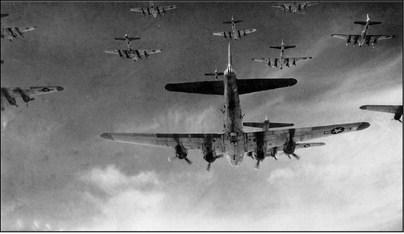The plane that Noel Shoup would eventually fly was an iconic four engine B-17 bomber that saw a lot of action during World War II. The B-17s dropped more bombs during World War II than any other aircraft. (Wikipedia, Boeing B-17 Flying Fortress).
It flew high and fast for its day. Its long range and load of 8,000 pounds of bombs in the belly of the plane made it capable of delivering them to strategic targets deep in Nazi Germany. It had numerous defensive guns on board at the expense of the bomb load. For the most part it was one tough plane. Wally Hoffman, a B-17 pilot said “The plane can be cut and slashed almost to pieces by enemy fire and bring its crew home.”
A prototype B-17 was flown in an Army Air Corp competition when it was first introduced in July, 1935. The army knew they liked the plane from the specifications. Later, a test flight was made determining the rate of climb and the ceiling of flight. Before take off, the plane had been held in a parking area. Gust locks were used to lock the flaps and other control surfaces to protect the plane from high winds. When the plane took off for the demonstration flight, the the locks were never removed. The plane stalled and spun into the ground shortly after takeoff. The pilot survived long enough to report that he had little control of the plane because the locks had not been removed. It is from this flight that the “check list” was established for all aircraft before take off. The army liked the capabilities of the plane and ordered 13 B-17s for evaluation in spite of the crash. The plane was eventually introduced into service in 1938. (Wikipedia, Flying Fortress/ Development).
Production was quickly ramped up as the United States declared war first on Japan and then on Germany in 1941. By the end of May 1945, 12,731 of these aircraft had been built in the three plants used by Boeing in California.
In July 1942 the first US Army Air Force B-17s were sent to England to join the Eighth Air Force. The B-17s were primarily used for precision daytime bombing against German targets such as U-boat pens, docks, warehouses, airfields and aircraft factories.
These targets were pinpointed in a campaign against the German military forces, as the Allies prepared for the D Day invasion. The Army Air Force wanted to do anything possible to reduce the Nazi’s ability to wage war.
On Aug. 17, 1942 Major Paul Tibbets along with Brigadier General Ira Eaker made one of the first bombing runs in Europe against the large Railroad Marshalling yards at Rouen-Sotteville in France. Half of the bombs landed in the target area, which at that time was considered a success.
The 8th Air Force began targeting the ball bearing plant in Schweinfurt with the plan to cripple their ability to build weapons. Attacks were made in August and again in October 1943. There were high losses of bombers due to German flack and fighter planes targeting the B-17s. The 8th Air Force continued their push with flights again on February 20 to 25, 1944 known as “Big Week.” (Wikipedia Boeing B-17 Flying Fortress) Noel flew a mission on February 28th to bomb Nazi V-2 rocket sites. It was during this flight into France that Nazi flack hit the main wing of his plane sending it into a death spiral. It was to be Noel’s 19th mission.
The policy of the Air Force was for service men to complete 25 missions, then the crew and their plane had the option of returning home to sell war bonds. The first B-17 heavy bomber in the 8th Air Force to complete 25 missions was the plane “Hell’s Angels.” “Memphis Bell” completed its missions one week later. (Wikipedia, Memphis Belle) The average life expectancy of a B-17 crew was 11 missions. (Source: 390th. org) Visit us at dublinhistorical. org.


